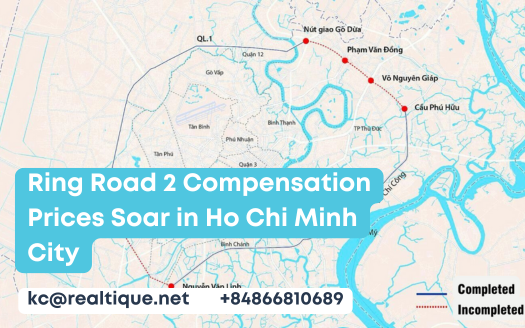Ring Road 2 Compensation Prices Soar in Ho Chi Minh City
The recent surge in prices associated with the Ring Road 2 project in Ho Chi Minh City, now exceeding 111 million dong per square meter, raises critical questions about urban development activity and economic implications. As this substantial infrastructure initiative progresses, it becomes essential to examine the compensation strategies for affected residents and businesses, alongside regulatory considerations influencing these price shifts. Understanding the broader framework of this project could reveal unforeseen consequences and opportunities for stakeholders involved—what might these developments mean for the future of urban connectivity and economic growth in the region?
Table of Contents
Overview of Ring Road 2
Frequently noted for its significance in urban infrastructure, Ring Road 2 in Ho Chi Minh City has recently seen its price escalate to over 111 million dong per square meter.
This essential project comprises two main segments traversing Thu Duc City. The first segment stretches 3.5 kilometers from Phú Hữu Bridge to Võ Nguyên Giáp Road, while the second extends approximately 3 kilometers from Võ Nguyên Giáp to Phạm Văn Đồng Road.
The project affects over 61 hectares, impacting around 1,166 households. As development progresses, Ring Road 2 is expected to enhance the city’s connectivity and mobility, playing a significant role in the broader urban development initiatives aimed at promoting economic growth and improving infrastructure in Ho Chi Minh City.
Compensation Strategies
As Ring Road 2 progresses, the compensation strategies implemented for affected residents and businesses are paramount to the project’s overall success.
A fair compensation structure has been established, with maximum prices reaching 111.5 million dong per square meter in the Phạm Văn Đồng area. Other regions, such as Đỗ Xuân Hợp and Đặng Văn Bi, feature compensation rates around 102 million dong per square meter, ensuring equitable treatment.
The lowest compensation in adjacent areas is over 26 million dong per square meter, while agricultural land receives up to 9.4 million dong per square meter.
These strategies aim to minimize economic disruption and promote community support, ultimately facilitating smoother project execution and enhancing urban development in Ho Chi Minh City.
Project Timeline
The timeline for the Ring Road 2 project is a crucial component in its successful implementation and reflects the city’s commitment to infrastructure development.
Ho Chi Minh City aims to complete the compensation phase by soon, allowing for public feedback from affected residents shortly after.
Construction is projected to begin in mid-2025, with both segments anticipated to be finished within two years from the start date.
Segment one will span 3.5 kilometers from Phú Hữu Bridge to Võ Nguyên Giáp Road, while segment two will cover approximately 3 kilometers, connecting to Phạm Văn Đồng Road.
This project is integral to the broader urban development initiatives in the region, enhancing connectivity and promoting economic growth.
Regulatory Considerations
Regulatory considerations play an essential part in the successful execution of the Ring Road 2 project, ensuring that all aspects of land acquisition and compensation align with existing legal structures.
The project adheres to the new Land Law regulations, which mandate fair compensation based on land type and location. High-potential development areas are prioritized for enhanced compensation values, reflecting their anticipated economic contribution.
Local authorities are prepared for necessary administrative adjustments, facilitating a smoother compensation process for the 1,166 impacted households.
Future Expansion Plans
Regularly assessing the urban development needs of Ho Chi Minh City, planners have outlined ambitious future expansion plans for Ring Road 2.
Two additional segments are currently in the planning stages: Segment three will extend 2.7 km from Phạm Văn Đồng to the Gò Dưa intersection, while Segment four will stretch 5.3 km, connecting National Route 1 to Nguyễn Văn Linh Road.
Both segments are expected to follow a build-transfer model, facilitating efficient public-private collaboration.
The completion of these segments is anticipated to enhance urban mobility significantly, improving connectivity and supporting economic growth in the region.
This strategic expansion reflects the city’s commitment to developing an extensive transportation network that meets the demands of its growing population.





